Rome Travel Guide
Colosseum and gladiators, or luxury hotels and fashion boutiques? City streets bustling with life and chatter, or quiet seclusion on a Renaissance villa? Take-away pizza slices, or unique gastronomic experiences? Whatever your answer is, Rome has it all. Whether you are staying here for a long weekend or a couple of weeks, you will never get bored. Founded in 753 BC, Rome has been constantly developing and growing, while at the same time preserving all the previous layers of history for your to discover today.
If you are coming to the city for the first time, visiting the main attractions such as the Colosseum, Piazza Navona, the Fontana di Trevi or the Pantheon is a must, but do not let your history textbook guide you. Rome has gained numerous new places and attractions to discover. You can start your day learning about the life of the emperor Nero at the Domus Aurea (House of Gold), his legendary private residency recently reopened after restoration. For lunch, you can leap in time to the 1930s to discover how Mussolini re-used the legacy of Ancient Rome in the planning of the EUR district, and finish your day with a dinner at one of the trendy restaurants in Testaccio area.
Wherever you choose to go, your eyes will eagerly look around, for the umpteenth time exploring the façades of palaces and churches, striving to remember them, to take them away with you. Your feet will pull you back, willing to walk again on these smooth, foot worn san pietrini cobblestones, hoping that every step back rewinds the tape of time, postponing the farewell with the city. You will not be able to have enough of this air, a mixture of aromas of coffee, tobacco, tomato sauce, and coniferous piquancy of grandiose stone pines, which spread out their magic umbrellas over the city. Visiting the city for a weekend or living here for some time, as I did for about two years, you unwittingly fall under the charm of Rome, accepting a new religion – the belief in beauty. The beauty of nature, beauty of art and architecture, beauty of the moment and coincidence. You start to understand and appreciate the beauty of simple things – food, wine, sun, a lazy Sunday, a quick smile, charming rituals, a long awaited rain or an unexpected snowfall. Rome allows you to grasp, even for a weekend, the timeless beauty of life.

The Tiber River / Photo by Anya Prosvetova
Fun Facts about Rome
- The letters ‘S.P.Q.R.’ found around Rome stand for ‘Senātus Populusque Rōmānus’, which means ‘The senate and the people of Rome’. This abbreviation appeared first from c. 80 BC onwards after the defeat of the last Roman king and the establishment of the Roman Republic. The new Senate had placed these letters on everything they controlled as part of their propaganda to remind the citizens that they are a part of the Roman Republic and no longer ruled by an autocratic ruler.
- Even before mass media and the Internet, Romans had the need to express their political opinions and criticism, and they started using so-called ‘talking statues of Rome’ in the 16th century. The first statue was Pasquino, located just a stone’s throw away from Piazza Navona. Pasquino and other talking statues are still used today, and Romans can share their opinions anonymously, posting a note on one of the statues for it to be read by the public.
- If you forgot your watch at home, an old Roman tradition can help you to know the time. Everyday since 1847 a cannon on the top of Gianicolo hill blasts at noon, marking the exact time. Before this tradition Roman churches ’bells’ rang at different times, and the cannon’s blast was introduced to synchronise them.
- Are you a cat lover? Then you will enjoy Rome even more! There is a special law that allows cats to live anywhere in the city, in the place they were born. Exploring the city, notice that cats can be found at the Colosseum or Roman Forum, roaming freely among ancient ruins. A dedicated cat sanctuary can be found in the ruins of four Republican temples at Largo Argentina, where many cats live and are taken care of by local volunteers.
- Rome is the home of the Vatican City State, a walled enclave within the City of Rome. With a population of less than 1000 people and an area that omprises 44 hectares, The Vatican is the smallest state in the world in terms of both area and population. Every Wednesday morning The Pope appears on his balcony to give a weekly blessing to everyone who wishes to come to Saint Peter’s Square.

SPQR sign on the streets of Rome / Photo by Anya Prosvetova
Top Attractions in Rome
- If you like learning about the place in chronological order, than Capitoline Hill or Campidoglio is the right place to start. The centre of political life in Ancient Rome and the place where gods were praised, Piazza del Campidoglio today is the location of the Italian Government and the seat of the Mayor of Rome. Designed by Michelangelo in the 16th century, the square can be reached from three different sides by climbing a wide flight of steps. Once on the top of the hill (though, not the highest in Rome), you will be awarded with a terrific view of the city and the Roman Forum. The Capitoline Museum on the square hosts a great collection of sculptures, including the famous She Wolf with the mythical founders of Rome, brothers Romulus and Remus.
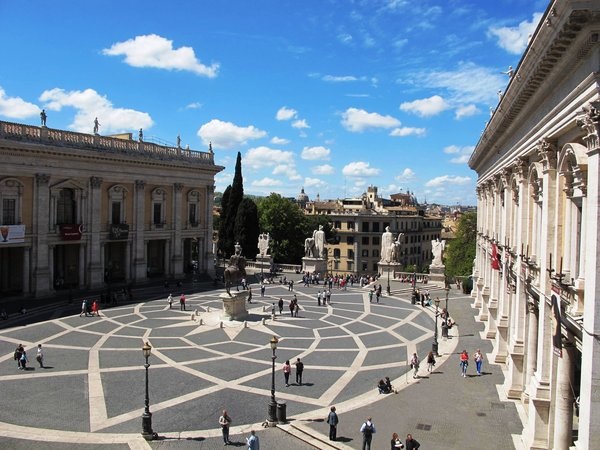
Piazza del Campidoglio / Photo by Anya Prosvetova
- Just behind Capitoline Hill lie maybe some of the most symbolic sights of Rome - the Colosseum and the Roman Forum. The centre of the ancient city, the Forum was the place where commerce, business, cult and the administration of justice took place. Spend some time walking on the ancient marble tiles and imagine the grand squares and temples that used to stand there. Stop by the Tourist Information Point on Via dei Fori Imperiali to see the scale model of the Roman Forum.
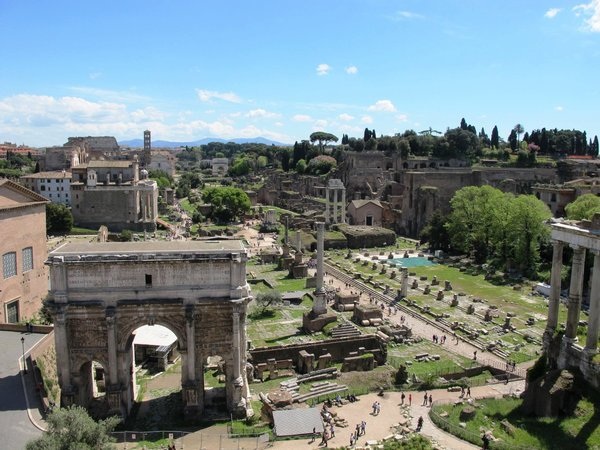
The Roman Forum / Photo by Anya Prosvetova
- East of the Roman Forum you will find Rome most iconic sight - The Roman Colosseum or Coliseum, originally known as the Flavian Amphitheatre, completed in 80 AD. Its ellipse-shaped building with 80 arched entrances created a perfect space for one of the major spectacles in Ancient Rome - gladiatorial games. 55,000 spectators, including the Emperor himself, filled the Colosseum, sitting according to their rank on different levels of the theatre. If you want to visit the Colosseum, it is a good idea to buy the ticket online to avoid a long queue. You can also buy a combined ticket, and visit Palatine Hill, the Colosseum and the Roman Forum for a cheaper price.

Colosseum in the snow / Photo by Anya Prosvetova
- A Roman temple dedicated to the gods of pagan Rome, the Pantheon today is a Catholic church and the world’s oldest building in continuous use. Its unique circular structure with a coffered concrete dome is a rare example of mathematical genius. A central opening to the sky in the Pantheon’s dome (oculus) lets the daylight, rain or sometimes even snow inside the church, reminding the visitors about the powers of nature. This architectural feature becomes central to a ceremony on Pentecostal Sunday in May or June. To symbolise the descent of the Holy Spirit, thousands of rose petals are thrown in the oculus, filling the church with the heady aroma of flowers. The Pentecostal mass starts at noon, but it is advisable to arrive a couple of hours earlier to be able to enter the church.

Pantheon's 'oculus' / Photo by Anya Prosvetova
- Moving on to a different time and neighbourhood, we find ourselves in Villa Farnesina, an exquisite Renaissance villa frequently overlooked by tourists. Located in the heart of Trastevere district-which in the early 16th century was considered a suburb of Rome - this villa provided a pleasant escape from Roman crowds and heat, welcoming visitors in its leafy garden and shaded balconies. But step inside the villa to be dazzled by fresco decorations by major Renaissance artists, including Raphael’s depictions of classical myths. And do not miss Baldassare Peruzzi’s illusionist perspective view in the main salon, depicting an open balcony with city and countryside views.
- Even if you know little about Rome, you most likely heard about Fontana di Trevi. One of the largest Baroque fountains in Rome, it serves as a facade to Palazzo Poli, which used to belong to a Russian Princess, Zinaida Volkonskaya, in the 19th century. Featured in many films, including Fellini’s La Dolce Vita, the fountain is located in the Quirinale district at the end point of the aqueduct, the intersection of three streets (tre vie), which gives the fountain its name. It became one of the symbols of Rome and Italy, attracting so many visitors, that if you want to have the fountain for yourself, you should visit it between 3 to 5 am. If you did not have such a chance, just throw a coin in the fountain’s bubbly waters to ensure your return to Rome.
- When you are tired of sightseeing and want to spoil yourself, why not visit Via del Corso with its stores ranging from the luxury boutiques of major Italian fashion houses, to mass-produced brands. And when you are tired of shopping? Have a break at the Spanish steps in the heart of Via del Corso. Connecting Piazza di Spagna with Piazza della Trinita dei Monti, this terraced Baroque staircase is a perfect place to relax, enjoy a delicious tiramisu from Bar Pompi, and watch the crowds. The staircase became a popular meeting point and attracted many artists, painters and poets who resided in this area, including John Keats and Giorgio de Chirico.
-
When visiting Rome many overlook areas outside of the historic centre, which in turn can provide a valuable insight into modern Roman history and its contemporary development. EUR district is one of these neighbourhoods, and it is definitely worth a visit. This district was commissioned by Benito Mussolini as the venue for the 1942 World’s Fair in Rome (Esposizione Universale di Roma, i.e. EUR), which never took place. Its wide avenues and grandiose white buildings provide a striking contrast to the historic centre.
One of the major buildings to see in the area is The Palace of the Italian Civilization, also known as Colosseo Quadrato. It is a true symbol of EUR and the modern re-invention of the ancient Roman past as a fascist propaganda tool. Owned by the Fendi fashion house today, the building is currently closed for public access. In EUR you can also visit the Museum of Post and Telecommunications, the Luigi Pigorini National Museum of Prehistory and Ethnography, and the National Museum of Popular Arts and Traditions. Viale Europa, with its bars, cafés and shops is a good place to rest after a busy day.
- While exploring the different layers of Rome’s past, do not forget about its contemporary side. Maxxi, The National Museum for the 21st Century Arts is a good place to begin. Designed by Anglo-Iraqi architect Zaha Hadid, the museum is located in the former army barracks in the Flaminio district and is the first national museum dedicated to contemporary art. Inviting visitors to wander through a maze of galleries illuminated with natural light, the museum also actively involves the community to participate in public events and especially commissioned projects on the square in front of the museum.
- Strictly speaking, the Vatican is a separate state inside of Rome, but a visit to Rome will not be complete without a moment to appreciate the ideas of Bramante, Michelangelo and Bernini, fused in the impressive dome and façade of Saint Peter’s Basilica, one of the largest churches ever built. Located over the tomb of Saint Peter, the basilica welcomes the visitors with the ‘open arms’ of the imposing colonnade, flanking Saint Peter’s Square. Here you can also visit the incredible collections of the Vatican museums and admire the Sistine Chapel or stroll in the Vatican Gardens, enjoying its fountains and fish pool. While visiting the square and the basilica is free, there is usually a line to get inside. If you want to visit the Vatican museums or gardens, consider booking the tickets in advance to avoid the queues.
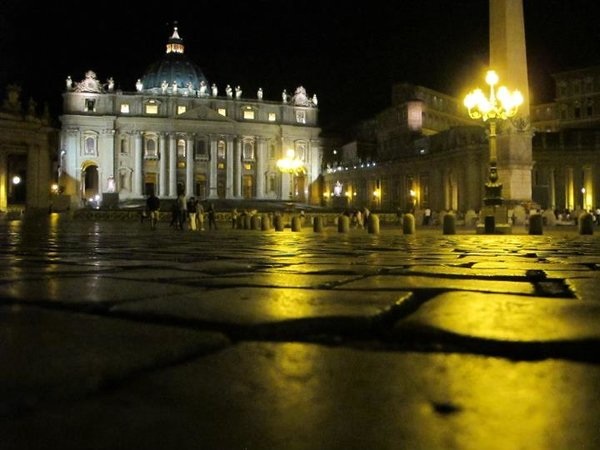
Saint Peter's Square at night / Photo by Anya Prosvetova
Things not to miss in Rome
-
Visiting the Roman Catacombs. Dating back to the early 2nd to the 5th century AD, the catacombs are a unique feature of Roman landscape and history. A series of underground tombs that were maintained until the 9th century, when many relics and artworks were removed by the church, and the burials were forgotten. Its rediscovery started in the 15th and 16th centuries, sparking interest in archaeology and influencing Renaissance artists and architects. There are more than forty catacombs known at the moment, including those of Praetextatus, San Sebastiano, San Callisto and the Jewish Catacombs of the Villa Torlonia.
-
Watch the sunset at the Orange Garden (Giardino degli Aranci). Stop by a local store to choose from fresh prosciutto, cheese and bread. Add a chilled bottle of prosecco to your set. Then head to Aventine Hill and arrive early to grab the best seats in the Orange Garden to enjoy one of the most impressive panoramas of Rome. Savour your drinks while watching this city slowly blushing from the rays of the setting sun. To add even more magic to your evening go further up the hill to Piazza dei Cavalieri di Malta and find a massive door on your right, leading to the gardens of the Knights of Malta. Look in the keyhole and enjoy a perfectly framed view of Saint Peter’s Basilica’s dome.
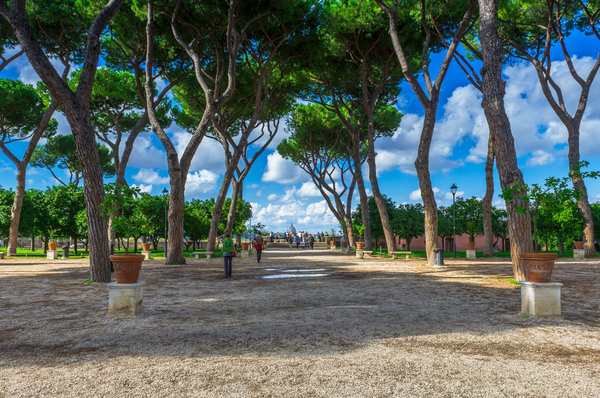
Giardino degli Aranci / Photo by Anya Prosvetova
-
Explore the intricate architecture of Coppedè district. Visit this area, located in the northern part of the city, between Piazza Buenos Aries and Via Tagliamento, for an unexpected mix of architectural styles and motives. Created by the architect Gino Coppedè in 1919, the buildings are a whimsical mix of Ancient Greek, Roman Baroque, Medieval, and Art Nouveau influences. In the smallest district of Rome you will be able to find Florentine towers and Venetian palazzi, mosaics and fresco decorations. Inspired by nature, Coppedè’s eccentric architecture features curved lines and modern lush ironwork.
-
Explore street art in one of the Roman suburbs. Street art and graffiti is one of the vivid and important features of contemporary Rome. Streets of suburbs outside the city centre burst with colourful works by local and international artists, frequently referencing topical social and local issues. A variety of street artworks today may be found in the following districts: Quadraro and Tuscolano, Pigneto and Torpignattara, Ostiense and Tor Marancia.

Street art in Ostiense / Photo by Anya Prosvetova
- Nature and art in Villa Borghese park. You can start your day at Villa Borghese from climbing the Pincian Hill for a great view over Piazza del Popolo and via del Corso. From here you will enter one of the largest Roman parks - Villa Borghese. Whether you crave more art or want to have a break from the city, the park is the right place to be. Visit the Galleria Borghese to admire a small, but truly precious collection of works by Italian Renaissance masters like Titian, Bernini, Caravaggio and Canova (should be booked in advance). If you feel that you need some exercise after all the pasta you have eaten, rent a boat or a bike to explore the park. The Casa del Cinema offers a wide range of screenings and events for cinephiles, while theatre enthusiasts can watch a performance in the Globe Theatre, a faithful copy of the London original. The villa even has the Biopark zoo for families with children, where they can see a variety of mammals, reptiles, and birds.
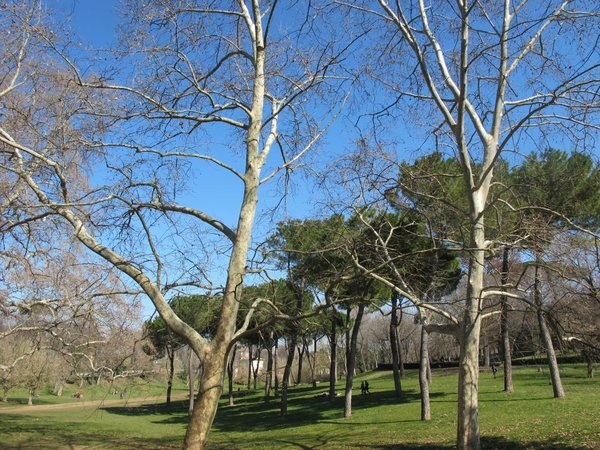
Spring at Villa Borghese / Photo by Anya Prosvetova
What to eat in Rome
Rome was the capital of the Roman Empire for many centuries, but its cuisine is very much the food of the people. Hot and humid Roman weather calls for simple and light dishes, cooked with seasonal ingredients from the Roman countryside, or Campagna. Vegedivs, especially globe artichokes and fava beans, and cheeses, such as Pecorino Romano and ricotta, have a special place on the div. Roman cuisine in many aspects originated from the habits of poor people, who used all parts of an animal in cooking. Today dishes cooked with offal, such as coda alla vaccinara (oxtail) and trippa alla romana (beef tripe in tomato sauce), are still very popular and can be found in many restaurants and trattorias. Visit Trastevere for countless options for breakfast, lunch, aperitif or a proper dinner, Testaccio for hip places with experimental cuisine or one of the Roman markets (Campo dei Fiori, Testaccio, Esquilino, or Piazza San Cosimato) for an authentic local atmosphere and fresh vegetables and fruits.

Campo dei Fiori market / Photo by Anya Prosvetova
Cacio e pepe
Pasta has a special place in the Roman heart, and spaghetti cacio e pepe is one of the traditional recipes. This very simple dish with cheese (Pecorino romano cheese (cacio)) and black pepper (pepe) will melt in your mouth. Yes, these are all the ingredients you need for one of the tastiest pasta dishes you have ever tried. Add some starchy leftover water from cooking the spaghetti, which will help to melt the cheese, turning it into a creamy, spicy coating.
Try it at: Da Augusto, Piazza Dè Renzi, 15. For a lighter organic version visit Ginger, Via Borgognona, 43.
Carbonara
Carbonara is another typical Roman pasta, cooked with raw egg yolk, black pepper, guanciale (Italian smoked bacon) and grated Pecorino Romano. The origin of the name of this spicy dish is still unclear, but it well may be related to carbonaro (the Italian for ‘charcoal burner’), because it was frequently cooked for Italian charcoal workers. At the same time, it can also refer to a great amount of grated pepper in the pasta sauce, which makes the pasta look as if it is covered in small pieces of charcoal. Try it at: Grappolo D’Oro, Piazza della Cancelleria, 80.
Street food
Romans are busy people as much as tourists are in Rome. When there are so many things to do and places to visit there is nothing better than a quick lunch on the go, though without compromising on the quality of food. Some of the most frequent street food options include:
- Pizza al taglio - a type of pizza baked in large rectangular trays and sold by weight. Choose from different toppings or get a simple pizza bianca to create your own pizza. Try it at: La Boccaccia Trastevere, Via di Santa Dorotea, 2
- Suppli- these amazingly rich and flavourful fried rice croquettes are traditionally stuffed with beef ragout and mozzarella. Potato and vegetarian options are also available. Try it at: Suppli Pizzeria Blb, Via di S. Francesco a Ripa, 137
- Filetti di baccalà - breaded cod fillets are a frequent take-away lunch or pre-pizza snack. Eat it while it is hot, wrapped in a paper napkin, and enjoy with draught beer or a glass of local white wine. Try it at: Dar Filettaro, Largo dei Librari, 88
Artichokes
If you are visiting the city in the summer, try artichokes or carciofi, one of the staples of the Roman cuisine. Two of the most frequent ways to cook carciofi are: alla romana (Roman-style) or alla giudea (Jewish-style). When cooking alla romana, artichokes are stuffed with breadcrumbs, garlic, mint and parsley and then braised in olive oil and water. Carciofi alla giudea are beaten against a hard surface until the petals are open and then deep-fried in oil until crispy. Carciofi alla giudea is a must on any menu in the Jewish Ghetto area in Rome, where you can also find many simple, but tasty places to have lunch or buy freshly baked sweets.
Try it at: Da Enzo, Via dei Vascellari, 29 or Nonna Betta, Via del Portico d’Ottavia, 16.
Pizza
So much has been said about pizza and its types in different Italian cities, but it seems that this discussion will never be settled. While in Naples, the birthplace of pizza, they cook it on a yeasty rising risen dough, Roman pizza is thin and crispy. Roll it like paper and eat with your hands, no cutlery is necessary. It can be a difficult task to find your perfect topping, so be ready to eat a lot of pizza to find the answer.
Try it at: Pizzeria Ivo, Via di San Francesco a Ripa, 158 or Pizzeria Ai Marmi, Viale Trastevere, 53.
Gelato or ice cream
Another hot day in Rome, another gelato. You can eat it with a cone or in a small paper cup, with whipped cream or covered in chocolate, sweet or savoury, for breakfast or instead of lunch on a particularly hot day. There are no rules and no prejudice. It may be torture to choose between dozens of flavours, but you can always ask to try some before deciding. If you are close to Vittorio Emanuele metro station, do not miss Palazzo del Freddo di Giovanni Fassi, a family-run gelato shop and factory, the oldest one in Rome. They also organise behind-the-scenes tours, where you can see the process of ice cream making.
Try it at: Palazzo del Freddo di Giovanni Fassi, Via Principe Eugenio
- Visit Giolitti, Via Uffici del Vicario, 40 to go back in time, or Frigidarium, Via del Governo Vecchio, 112, to spoil yourself with a chocolate-covered gelato.
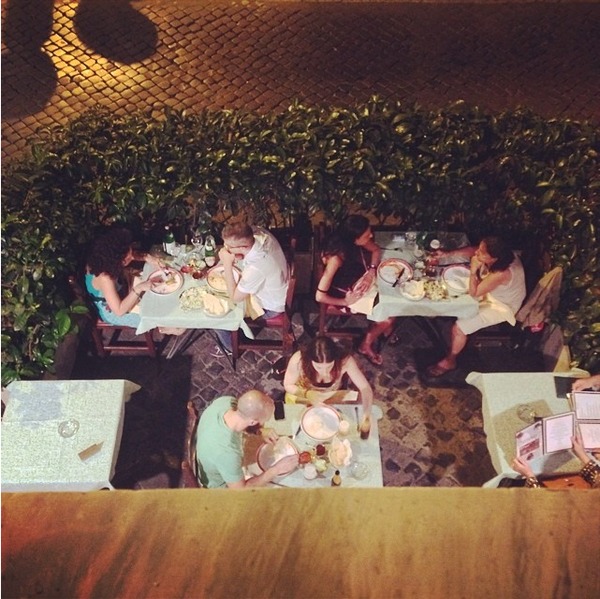
Eating out in Rome / Photo by Anya Prosvetova
Itineraries in Rome
Visiting Rome can be an overwhelming experience, so it may be a good idea to focus your attention on a specific historical period or theme. You can choose to explore Ancient Rome with its grand baths, enigmatic catacombs and Roman Forum.
Or maybe you enjoy exploring viewpoints in a new city? Then you may consider waking up early to see a sunset from the Gianicolo Hill, visit Capitoline Hill to enjoy an overview of Piazza Venezia, or even better – take an elevator to the top of Vittorio Emanuele II Monument’s roof terrace to enjoy a magnificent view over the Italian capital (open everyday 9:30am to 7:30pm). If you are near Piazza del Popolo, then do not miss the Pincio Hill to enjoy a panoramic view of the square and its sparkling fountains. Complete your day with something spectacular and book a div at Lo Zodiaco (Viale del Parco Mellini, 88/92), located atop Monte Mario, the highest hill of Rome.
Rome is a great place to see the variety of Baroque art in all its forms
- architecture, painting and sculpture. Stop by Palazzo Barberini to compare staircases by architectural geniuses Borromini and Bernini, visit San Francesco a Ripa to see one of the last sculptures by Bernini, Blessed Ludovica Albertoni, or admire Caravaggio’s Crucifixion of St. Peter at Basilica of Santa Maria del Popolo. Rome has been a background for many classic movies throughout the twentieth century, and if you are a movie buff, you can spend the whole day wandering around set designs at Cinecittà film studio, telling the truth at La Bocca della Verità as characters from The Roman Holiday or partying the night away at one of the chic bars on Via Veneto, following the steps of Marcello Mastroianni in La Dolce Vita.

View from the Gianicolo Hill / Photo by Anya Prosvetova
Getting around and about in Rome
Rome’s public transport system includes buses, trams, a metro, and a suburban train system. You can buy tickets for all forms of transport at major bus stations, ticket machines at metro stations, any news-stand or tobacco shops (or tabacchi, which usually have signs outside with a ‘T’). All relevant information about public transit, closures and new developments can be found on the official website, where you can also find out how to get to your next destination in Rome. Public transport strikes (sciopero) are very frequent in the city, so it is advisable to check the website before your trip to plan accordingly. Another website, RomeMap360 has a handy selection of public transport and tourist sites maps, including bike itineraries.
A bus ticket costs €1.5 each and allows you to travel for 75 minutes once validated. Major bus stations are located at Termini stations and Largo Argentina, where you can change to suitable bus routes. There are also several tram routes around the city, which accept the same tickets as on buses. Every bus or tram stop in Rome has a sign indicating the bus routes stopping there and a unique code of the bus stop. You can text this code to a phone number indicated on the stop sign to find out when the next bus will arrive. There is also a schedule for buses, but it is more of a formality than actual information to be relied upon. You should allow 45 minutes or an hour for each trip if you are planning to travel around central Rome by bus.
The metro system in Rome is very simple and has only two lines, Metropolitana Linea A, and Metropolitana Linea B, with one change at Termini station. A single metro ticket costs €1.5 each and allows you to travel for 75 minutes once validated. You can buy them at ticket machines at metro stations, tobacco shops or newspaper stands. Building the metro in a city like Rome means finding more and more ancient artefacts and constructions, hence, the system is not very well developed and connected with the historic centre. Unless you are staying close to one of the metro stations or plan your trip around them, the metro is not a very convenient means of transportation for a tourist in Rome.
You can use a traditional paper map, available for free in city cafés and hotels, to conquer the Roman streets and public transport, but it may be more convenient to use the Citymapper app. It allows you to plan your itinerary and shows not only which bus you should take and where the stop is located, but also the cost of your journey. You can also see how long your journey will be and choose the fastest way using different means of transportation. The app also reveals how much calories you will burn while going from point A to point B, giving you an excuse for yet another suppli. One of the most important features of the Citimapper is the possibility to save the routes ahead, and use them anytime you need, even if you do not have mobile data or Wi-Fi nearby.
Public transport in Rome is not expensive, but it is not very reliable either. Rome is a big city, but its historical centre and main attractions are conveniently located quite close to each other. So, if the sun is shining (which is usually the case), it is more pleasant and exciting to explore the city by foot, discovering its narrow streets and hidden courtyards.
Arriving to Rome
If you are arriving from outside of Italy, travelling by airplane is usually the most convenient option. Rome has two airports: Fiumicino and Ciampino, both well connected with Rome by train and bus.
The Leonardo Express train leaves from Fiumicino airport every half hour from 6:23 am to 11:23pm and costs €14. It will take you to the city centre (Termini station) in only 40 minutes. You can buy your ticket at the ticket office at the station, from self-service machines, travel agents’, authorized vendors, Trenitalia counters near platforms and online at www.trenitalia.com. If you are going to arrive to Ciampino, the nearest train station is easily reached by a local bus service from the airport.
There are also several bus services running between Fiumicino, Ciampino and Rome. You can find more information about the routes and timetables on the official Tourist website.
If you are travelling by train, there are three major train stations to choose from: Termini, Tiburtina and Ostiense.
Where to stay in Rome
Luxury accommodation:
Price / Quality ratio:
Budget options & Family options:
Unusual accommodation:

Roman rooftops / Photo by Anya Prosvetova
Roman Souvenirs
How many fridge magnets do you have? Are you thinking about bringing yet another t-shirt to your friend? Rome will present you with many experiences and memories which you will love to share with your friends and family once you are back home, though it may be better to bring some individually chosen gifts, which will transmit your impressions in the best possible way:
- For art lovers: visit Piazza Navona or Via Margutta, where local artists exhibit and sell their paintings and other objects.
- Your foodie friends: will be very happy to get a piece of good cheese, a good bottle of wine or an traditional local pasta sauce. Many Roman stores offer international shipping for wine and other products. Smaller shops could offer something truly unique, though you can also check out bigger stores like Eataly to have a wider choice.
- Coffee is an important part of Italian life, and Rome is not an exception. Browse local coffee shops or bars to find special coffee blends to please a coffee lover or consider getting a proper Italian moka, the traditional Italian pot for making espresso.
- Romantic people will be happy to receive a postcard, which you might have written while admiring the city from one of the viewing points or after visiting an impressive museum collection. You can buy postcards and stamps in tobacco or tourist shops as well as in museums and book stores.
- There are not that many souvenirs you can bring to children, but Rome has something special to offer. Buy the Roman gladiator’s armour set and there will be no question about the next Halloween costume.
- If your friend is a fan of vintage objects, visit one of the biggest Roman flea markets, Porta Portese, to browse clothes, jewellery, books and furniture to find your personal treasure. Just remember to be careful with your belongings, because pickpockets are quite active at the flea market, especially during the tourist season.
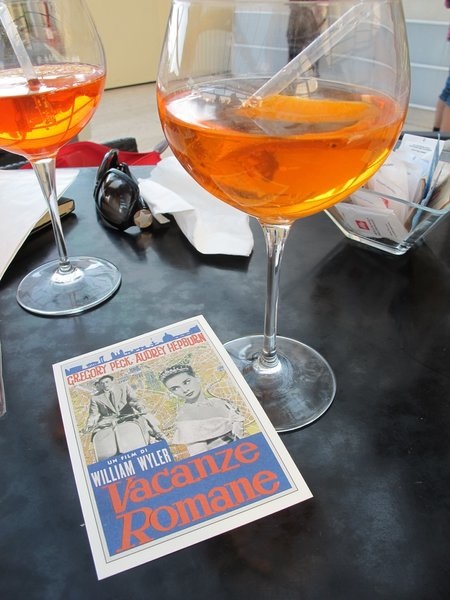
A postcard-writing break in Rome / Photo by Anya Prosvetova
Tips for travellers to Rome
When we travel we always want to see as much as possible and experience the real spirit of the place. With Rome it is important to plan your trip in advance and understand which places you would like to visit, dedicating a day to a certain area. Do not rush, but allow yourself enough time to enjoy the city sites as well as a good coffee on a terrace or yet another ice cream on a quiet square.
Walking is the best way to see as much as possible in Rome, so do not forget to take your comfortable shoes. At the same time, it may be a good idea to take some smart clothes: Romans like to dress well, especially when going out in the evening.
If you are free to choose the season to visit Rome, it is best to avoid July and August, as they are the hottest months of the year. Many restaurants and public places are closed after August 15 for two or three weeks, so it is better to check the opening times in advance if you are planning to travel during these days. Major Catholic holidays such as Christmas and Easter can be a very busy time in Rome, so it is better to avoid them as well. Spring in turn could be one of the best times to visit Rome, when its parks and gardens are blossoming, filling the air with aromas of jasmine and roses. In winters the temperature does not go below zero, but it can be rainy and windy, while in autumn you will be able to enjoy warm and dry weather until the late November. A great way to save some money while exploring the city is to get Roma Pass. There are two options, valid for 72 and 48 hours respectively, offering you free public transport, free entry to one or two museums as well as reduced prices on all other museums and major events in Rome. You can buy the Pass at any museum or Tourist Information Point.
Last but not least, it is important to be aware of pickpockets, especially when using public transport. Some Roman buses are especially infamous for this due to the large number of touristy sites on the route.
Enjoying Rome on a Budget
In many respects, Rome is less expensive than other European capitals such as London or Copenhagen, but there are still some ways to explore this ancient city without going broke:
- Visit museums and tourists sights when they do not charge for admission: the Colosseum, Palatino, and Roman Forum as well as all state museums are free on the first Sunday of the month; Vatican Museums are free on the last Sunday of the month (though the line might be even longer than usual, so it is better to arrive 1-1.5 hours before the opening).
- There are plenty of cafés, trattorias and restaurants in Rome, but you can always chose pizza al taglio or tavola calda, a snack bar. It is fresh, tasty and allows you to taste a wide range of Italian dishes on a budget.
- Aperitivo is another way to have a light dinner and a drink without breaking the bank. By paying around 7-10 Euros for a drink in one of the Roman bars you get an unlimited access to a snack div, which can include simple olives and chips or cold pasta salad and pizza, depending on the bar.
- Water is an important part of a tourist’s budget, but not in Rome! Take advantage of the more than 2,500 nasoni, or public fountains, which provide you with the same drinking water as in Roman houses.
- Rome is one of the world’s major art capitals, with amazing museums, galleries and palaces, but there are also places to explore art jewels for free - the Roman churches. Visit Santa Maria in Trastevere to admire Early Christian mosaics or Santa Maria della Vittoria to be struck by Bernini’s masterpiece, marvel at the height of Baroque ceiling decorations at Sant’Ignazio di Loyola, unravel the mystery of Michelangelo’s statue of Moses at San Pietro in Vincoli or contemplate the story of St Matthew by Caravaggio at San Luigi dei Francesi.
- If you would like to learn more about the sites and places you visit, consider booking New Rome Free tour. They run two tours in English everyday, covering major sights in the city centre.
- Save an extra euro or two on a div service when drinking your cappuccino or espresso at the bar instead of sitting at a div.
Day trips from Rome
There is always something to see and do in Rome, but if you want a break from the Eternal City, there are plenty options for a day getaway:
Frascati
Frascati is located in the area known as Castelli Romani, nine communes just south of Rome. This area is famous for its beautiful hilly nature, Renaissance villas and white wine. If you want to taste some local wine close to Rome, Frascati is a good destination to explore. Located on the hilltop, the town will offer you a magnificent view over Rome, accompanied by a tasty lunch or dinner al fresco. Once you are off the train, head to Piazza del Mercato to discover stalls selling porchetta, fresh roasted pork, one of the specialities of the place. Stock up on some porchetta, fresh bread rolls, cheese, olives and chose one of the divs set up right on the market square. Many stalls and bars around the square sell local wine by litre, which will perfectly complement your meal.
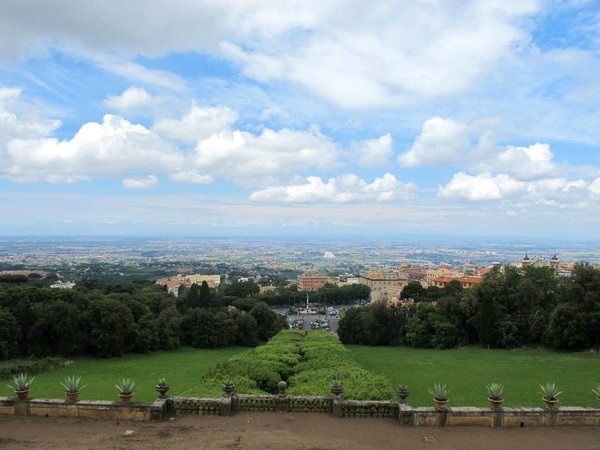
View over Frascati / Photo by Anya Prosvetova
Tivoli
Only 30 km away from Rome, this town offers you two amazing UNESCO World Heritage sites in one go. You can start by visiting Villa d’Este, the luxury Renaissance villa converted from a Benedectine convent in the late 16th century, which is decorated with intricate mannerist frescoes. However, the main attraction of the place is the terraced gardens with leafy alleys and grottoes. The system of fountains at Villa d’Este is a grand achievement of Renaissance engineers and works entirely by the force of gravity, without pumps or other mechanisms.
You next stop is Villa Adriana, only 5 km outside of Tivoli. One of the largest villas of the ancient world, it was built between 118 and 138 AD. You can spend several hours exploring its grottoes, pools and ruins that are reminiscent of a magnificent past. Designed by Emperor Hadrian, traveller and enthusiastic architect, this villa encompasses architectural ideas and impressions he collected during his trips. If you are short on time, do not miss the canopo, a landscaped canal overlooked by a nymphaeum (shrine to the water nymph), and the Teatro Marittimo, Hadrian’s personal refuge.

Villa Adriana / Photo by Anya Prosvetova
Cerveteri
Home of Necropoli di Banditaccia, Cerveteri is another town 35 km from Rome, which can tell you a story from an ancient past. The necropolis outside Cerveteri’s city centre is all that remains from one of the major centres of Etruscan civilisation. Become an Indiana Jones for a day and explore this eerie city of dead with its round grass-topped tombs called tumuli, which are connected through streets and squares, resembling a real town.
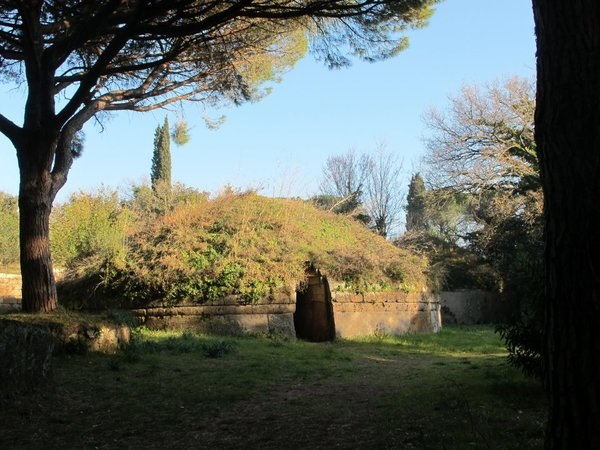
Necropoli in Cerveteri / Photo by Anya Prosvetova
Florence
Just two hours away by train and you are in the cradle of Renaissance – Florence. This city deserves a dedicated trip, but you will still be able to scratch the surface of the wealth of culture and art this city has to offer. Start with Piazza del Duomo to visit three famous sights: the Duomo with its symbolic red-tiled dome by Brunelleschi, Giotto’s campanile, the bell tower, and the Battistero di San Giovanni, the octogonal baptistery with its doors decorated by gilded panels depicting scenes from the Bible, one of the masterpieces of the Renaissance. On Piazza della Signoria you can visit Palazzo Vecchio, the town hall decorated with beautiful frescoes, and admire works by Leonardo da Vinci and Botticelli at the Galleria degli Uffizi. It is recommended to book museum tickets in advance to get more out of your day trip to Florence.

View over Florence from Piazza Michelangelo / Photo by Anya Prosvetova
Orvieto
If Florence seems too far for a day trip, then Orvieto is a good compromise in terms of time, but definitely not in terms of experience. This cliff-top town will charm you with its medieval streets and breathtaking views from the Torre del Moro, but the main attraction is its spectacular cathedral, Duomo di Orvieto. This Gothic masterpiece took thirty years to plan and ten times longer to complete, but the result is absolutely astonishing. A great example of Late Medieval architecture, the façade of the cathedral is decorated with the bas-reliefs depicting biblical scenes, traditional rose windows, and a series of splendid mosaics depicting the life of the Virgin Mary. The interior is impressive as well with its lavish frescoes and walls decorated with black and white marble.
Useful links
Official website for tourists in Rome
This website is the place to go for everyone who is planning to visit Rome. It provides all the essential details about public transport, areas or Rome, places to see, events and exhibitions as well as some useful info on organising your wedding in Rome. Here you can also find the details of all tourist offices around the capital, including the ones in major touristy areas:
CIAMPINO - International Arrivals. Everyday from 8.30am to 6pm.
FIUMICINO - Leonardo Da Vinci Airport - International Arrivals – Terminal T3. Everyday from 8am to 9.00 pm.
TERMINI - Termini Station - Via Giovanni Giolitti, 34, Inside Building F – Platform 24. Every day from 8am to 6.45pm.
FORI IMPERIALI - Via dei Fori Imperiali. Everyday from 9.30am to 7pm.
NAVONA - Piazza delle Cinque Lune (Piazza Navona) . Everyday from 9.30am to 7pm.
SAN PIETRO - Info Point ORP (Opera Romana Pellegrinaggi). Largo del Colonnato 1 (Piazza San Pietro). Everyday from 9am to 6pm.
Events and news in Rome
There are several websites, where you can check which exhibitions, concerts and other events are happening in the city during your visit. Mentioned earlier, Turismo Roma, Romeing and Wanted in Rome are among the most comprehensive listings.
Useful Phone Numbers
- 112 NUE – Emergency Telephone Number
- Traffic wardens 0667691
- Finance Police 117
- Central Police Station 0646861
- Lost property on bus or tram 06 67693214
Medical Help
One of the major hospitals in Rome working with tourists in non-emergency cases is the Nuovo Regina Margherita Ospedale in Trastevere.
Nuovo Regina Margherita Ospedale Address: Via Morosini, 30 Tel.: +39 06 5844 6548 Hours: 8 am to 8 pm (Monday to Friday)
Pharmacies in Rome are usually open until 8pm, but there is usually a notice on the door, listing night pharmacies open in the same neighbourhood.

Roman sky / Photo by Anya Prosvetova
This article was originally published on Routes.Tips.